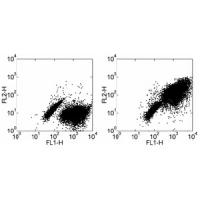Ccr7 Rat Monoclonal Antibody [Clone ID: 4B12]
Other products for "Ccr7"
Specifications
| Product Data | |
| Clone Name | 4B12 |
| Applications | FC |
| Recommended Dilution | Flow, IP |
| Reactivities | Mouse |
| Host | Rat |
| Clonality | Monoclonal |
| Formulation | Aqueous buffer, 0.09% sodium azide, may contain carrier protein/stabilizer |
| Concentration | lot specific |
| Purification | Affinity purified |
| Conjugation | Unconjugated |
| Storage | Store at -20°C as received. |
| Stability | Stable for 12 months from date of receipt. |
| Gene Name | chemokine (C-C motif) receptor 7 |
| Database Link | |
| Background | The 4B12 monoclonal antibody reacts with mouse CCR7, also known as EBI-1 and CD197. CCR7 is a chemokine receptor for the chemokines CCL19 (CK?11, ELC, MIP3?, Scya19, Exodus-3) and CCL21 (CK?9, SLC, MIP2?, Scya21, Exodus-2). In recent years, the role of chemokines in directing the migration of lymphocytes has been well-characterized. One of the most important mediators of homeostatic trafficking of na?ve T cells to secondary lymphoid organs (SLO) is the chemokine receptor CCR7. Binding of its ligands, CCL19 and CCL21, mediates the trans endothelial migration of T cells across high endothelial venules into SLO. It has also been demonstrated that CCR7 plays a role in the localization of dendritic cells and B cells during an immune response.CCR7 is a chemokine receptor for the chemokines CCL19 (CK?11, ELC, MIP3?, Scya19, Exodus-3) and CCL21 (CK?9, SLC, MIP2?, Scya21, Exodus-2).In addition to its significant role in the chemotaxis of lymphocytes, human CCR7 has also been recognized as a marker for a distinct subset of memory T cells, the central memory (TCM) population. These cells are characterized by the expression of CCR7 and CD62L and reside within peripheral lymphoid organs. CCR7 also plays a role in thymocyte development and its deficiency leads to disturbed thymic architecture, aberrant T cell development, and limited thymocyte expansion.For optimal visualization of CCR7 expression on different cell types it is necessary to use multi-color staining to discriminate different cell subsets as well as following the protocol (incubation at 37C may be necessary). To address specificity, the staining profile of 4B12 has been compared to a polyclonal antibody generated against a CCR7 peptide (Bjorkdahl et al). This analysis confirms that the polyclonal antibody and 4B12 stain similar populations of cells. Furthermore, 4B12 stains mouse CCR7-GFP fusion protein-transfected RBL cells (see data in cat. 14-1971). |
| Synonyms | BLR2; CC-CKR-7; CCR-7; CD197; CDw197; CMKBR7; EBI1; EVI1 |
| Reference Data | |
Documents
| Product Manuals |
| FAQs |
{0} Product Review(s)
0 Product Review(s)
Submit review
Be the first one to submit a review
Product Citations
*Delivery time may vary from web posted schedule. Occasional delays may occur due to unforeseen
complexities in the preparation of your product. International customers may expect an additional 1-2 weeks
in shipping.






























































































































































































































































 Germany
Germany
 Japan
Japan
 United Kingdom
United Kingdom
 China
China



